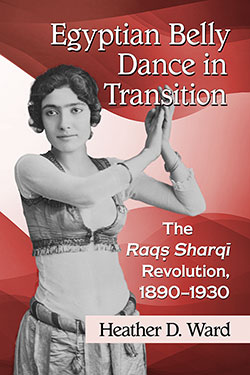
Egyptian Belly Dance in Transition: The Raqṣ Sharqī Revolution, 1890–1930
Tom Verde
Heather D. Ward
2018, McFarland Books, 978-1-47666-674-7, $39.95 pb.
Cultural historians have asserted that raqṣ sharqī (eastern dance)—public interpretations of raqṣ baladi (belly dance) performed at private celebrations like weddings—evolved during the British colonial era in Egypt in the late 19th and early 20th centuries in response to Western influences and desires, Ward writes in this study of the often-stereotyped art form. She argues that raqṣ sharqī was in fact a rebellion against foreign occupation, “a product of Egyptians actively defining and asserting their cultural and national identity.” Drawing on Arabic primary sources including accounts by “Egyptians who created the dance themselves,” the book takes readers into the Arab-owned, colonial-era entertainment halls where raqṣ sharqī was presented. We learn that the outfit worn by dancers was not “a Western fantasy costume,” but descended from “an indigenous (though Ottoman-influenced) … style.” What was seen on stage was not some titillating Orientalist vision, “but hybrid cultural expressions … embraced as authentically Egyptian.”
You may also be interested in...

Umayyad Family Dynasty Creates Unprecedented Empire
Explore the development and history of the Umayyad Caliphate, one of the most consequential empires the world has ever known.
British Library’s 500-Year-Old Nizami Manuscripts Shed Light on Power of Art and Poetry in 12th-Century Herat
Persian and Mughal scholar and specialist Barbara Brend presents a comprehensive study of one of the most highly esteemed works of Persian Literature.
Noorjahan Bose: A Life of Learning
Taking inspiration from her now-deceased mother, Noorjahan Bose, a daughter of the Agunmukha, Bangladesh, now shifts her energy toward empowering other daughters.